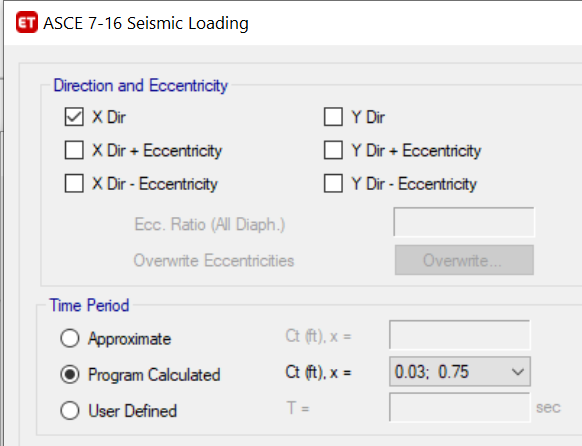Search the Community
Showing results for tags 'time period'.
-
I was just looking at ACI/ASCE method for seismic design and had a general question about this new spectrum analysis method. Quest 1 : As it says in the code to use values of (SA 0.2 sec, SA 1sec) which means generalized Time periods are taken as 0.2 for short and 1 sec for tall buildings for given site. Why these time period values are generalized? Isn't it very common for a structure to have a time period way greater than 1 sec?. How we design for buildings having more than (say) 30 stories if we restrict its time period to just 1 sec (maximum)? Quest 2: What is difference between fundamental time period (usually varies from 0.7 to 1.X) which we find as a result, and the one we use in the ETABS seismic data (i.e. 0.030 for concrete)?
-
Salam I am analyzing six story building and the time period of my building is 1.2 sec but my drift is under control.I have checked my all nodes and they are attached.I want to know either it is ok to go with this too high time period.I have attached my model and it is in 2016 version. 1 MODAL.EDB
-
please tell me how can I get fundemental period of structure in etab
-
why time period by Method 'A' is less than Method 'B'. As Tb=1.3Ta .I want to know the reason of this factor.
-
Assalam o alaikum Dear friends, I have two questions. I am to detail SMRF for zone 3. I was reading ACI 318-11 chapter 21. Now i have some confusion. 1) 21.1.1 says, ........................................For which, design forces , related to earth quack forces, have been determined on the bases of ENERGY DISSIPATION IN NONLINEAR RANGE OF RESPONSE. My question is What is meant by energy dissipation in non linear range of response?? What i have get through my research and understanding is, When Earth quack comes, due to inertia of building, it produces lateral forces in building. Due to these forces, structure deflect. If members of structure have big amount of reinforcement and cross sections, the force (or in other words energy) exerted by earth quack to the building will not yield the members and structure and members will restore to initial positions. In this case, members will not yield, and will remain in ELASTIC RANGE. But this makes structure too costly. On the other hand, if members have ability to yield but not fail, this energy will be used to yield the members and hence much of this energy will be dissipated in non linear range of members response. And we design structures for this because this is does not make structures too costly. So we design structure in the 2nd way. But due to this energy dissipation , structure is no longer in use at service stage and needs some or much requirement. We compromise over serviceability stage upto some extent and does not compromise over limit stage.. Is my concept right???? Is this the mean of energy dissipation in non linear range of response?? 2) Commentary of R 21.1.1 says, The integrity of the structure in the inelastic range of response should be maintained because the design earth quack forces, defined in documents such as ASCE/SEI 7, the IBC, the UBC and NEHRP provisions are considered less than those corresponding to linear response at the anticipated earthquack intensity. What does it mean?? Jazak Allah...
- 7 replies
-
- energy dissipation
- aci 21.1.1
-
(and 1 more)
Tagged with:
-
hello, I am modeling an RC building using etabs 2013, I need help in several thing: 1- The story shear along X and Y are not equal 2- The deflection in z direction is so large 3- The period of the first 3 mode is very high any help? Thank u
- 28 replies
-
- Story shear
- Time Period
-
(and 1 more)
Tagged with:
-
what is difference b/w Natural and Cyclic Frequency? i shared a snapshot of summary report of ETABS..




.thumb.jpg.700916fbc7ead330085e15745d0270bd.jpg)
